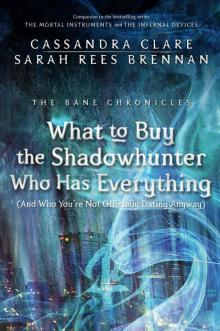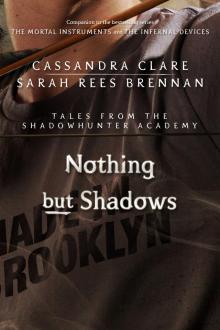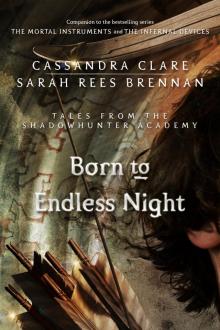- Home
- Cassandra Clare
Shadowhunter’s Codex Page 12
Shadowhunter’s Codex Read online
Page 12
WHY?
The great question of the Nephilim, the great mystery left unanswered by Raziel and unasked by Jonathan Shadowhunter, is this: Why have we been left with such limited powers? Why have the Downworlders been given such a range of superhuman abilities—immortality, strength, and speed beyond their physical bodies, the ability to invent and create new magic—when we have been given such limited and unchangeable weapons for our fight?
This is a question without an answer, and in fact to suggest a definitive answer is to presume to know the minds of angels. Let us, however, suggest that the Shadowhunter hold within her mind two qualities of great warriors—that of dignity and that of humility.
Dignity: Our power is that we are chosen. Unlike demons, born of the Void and without the free will to choose aught but evil; or Downworlders, whose powers are so often the result of accidents of birth, unpredictable events, terrible crimes; we have been selected to bear the blood of angels and lead the fight against Hell.
And humility: We are dust and ashes. We are mortal. We are vulnerable. We bleed and we die.
And in these two extremes is our great strength and our great frailty.
This: Cheesy but true! This kind of describes all people.
We count as people!
Do I even have to say you can skip this sidebar?
What, I didn’t hear you. I was busy skipping this sidebar.
* * *
BASIC INTERDIMENSIONAL SPACE-TIME THEORY
So far you know of two worlds: the mundane world and the Shadow World. But there are worlds other than these. Our world overlaps with others, infinitely many others, that are separate from our world yet occupy the same space, in an alternate reality. These alternate realities have no obligation to hew to the same rules that our own universe follows, and so it’s generally assumed that we could not survive in most of them. Not only need they not have things such as water and air and a temperature that we can stand, but they need not have the same physical laws or forms of life, and in these worlds we might disintegrate, unable to sustain our existence in a universe totally hostile to it.
Some believe Faerie to be a dimension different from our world (see discussion of the fey, Bestiaire Part II, Chapter 4), but we know for sure that the Void, home of the demons, is a different dimension. Attempts to follow demons home through their Portals back to the Void have proved to be instantly fatal to humans. It’s suspected that angels come from yet another dimension, but this is mere speculation.
In truth we don’t know whether the Void is a single alternate dimension—or many dimensions, or even an infinitude of dimensions whose nexus lies at Pandemonium. In practice it does not much matter. Our vocation as Nephilim is to protect our own dimension; we will allow other universes to take care of themselves.
You shouldn’t have skipped it. This is cool stuff.
Space-time! Dimensions! More of this kind of thing please, thanks, love Simon.
GLAMOURS AND THE SIGHT
A glamour is the simplest magic in existence. It makes things look different from how they are. Performed correctly, it creates a perfect semblance in the mind of the observer and perfectly obscures the true shape of the thing glamoured. It is one of the few kinds of magic available to all known magic users—it is found in the Gray Book, in demonic spell books, in the researches of warlocks, and among the fey. And a glamour is the most widely and extensively used magic because of its necessity: It hides the Shadow World from mundanes, a goal that all of that world agrees upon.
Most glamours are easy to see through for any magical being, and they usually hide things only from mundanes. Vampires, faeries, and warlocks all may use more powerful glamours to hide their activities not just from mundanes but also from Shadowhunters and from one another. Faeries especially are considered the masters of glamour magic; some Nephilim theorize that everything we see of Faerie in this world is modified by a glamour in some way.
Glamours are most commonly used to put a false skin over something, as with the glamours we place on our Institutes. Nephilim also often glamour ourselves into invisibility, to move undetected through the mundane world. This is significantly easier than glamouring gear into the semblance of street clothes, weapons into the semblance of harmless tools, and so on. Similarly, demons may glamour themselves into nonspecific forms, so that a mundane attacked by a demon will perceive it as something generic, like a dog or another random mundane.
The ability to see past glamours to a thing’s true nature is often called the Sight, a term from mundane folklore. Most Shadowhunters are born with the Sight, inherited from their Shadowhunter parents. All Shadowhunters typically enhance their Sight with the permanent application of a Voyance rune, because Sight is the only means of seeing through glamours. Just knowing that something has been glamoured, or even knowing its true shape, does not remove the glamour effect.
This is notable because there are many folk beliefs among mundane cultures about rituals and tools that can be used to see through glamours. Some of these may successfully work to help us see through faerie glamours, by means we do not understand. These tools—clary sage, Seeing Stones, wearing clothing inside out, washing your face in a particular spring at sunrise, and so on—cannot, however, be used to see through the more common glamours used by warlocks, demons, and Shadowhunters.
Some mundanes do naturally possess true Sight, usually credited to fey blood in their ancestry, though no direct connection has ever been proved.
* * *
WHAT IS A GLAMOUR?
The origin of glamour magic is a subject that has puzzled generations of magical researchers—how is it that all of the Shadow World has access to it, and are the different versions related? There have been various theories, the most common of which historically has been that glamour magic originally belonged to the fey and was “stolen” from them by other creatures somehow. It’s not clear how this could have happened, though, and so the prevailing theory today is that there are at root two types of glamours—the angelic glamours that we Nephilim use, produced by the inscription of Marks, and demonic glamours, used by everyone else. It’s assumed that Raziel granted us the power of glamours, just as he granted us the power of Sight, to put us on an even footing with our foes, and to allow us to protect ourselves from mundane discovery.
I did not know this, but it turned out to be because I did not care.
ANGELIC MAGIC
THE MORTAL INSTRUMENTS
The Mortal Instruments are the greatest gifts entrusted to the Nephilim. Without them there are no Shadowhunters, no Marks used by humans, and no recourse against the demonic threat. The Instruments are venerated by Shadowhunters as our most sacred relics and are given to the Silent Brothers to keep and protect.
It is believed that the Mortal Instruments have functions beyond those that we know; old writings, especially among the Silent Brothers, speak obscurely of angelic powers essential to the Instruments that could be wielded if only we knew what they were. These powers remain ineffable to us. Sadly, no use has ever been found for the Cup or the Sword beyond those enumerated below, and, of course, we do not know what power, if any, the Mirror might possess.
The power of dunking you in a lake and then driving you mad. Well done there. So glad we know about that now.
THE CUP
The Mortal Cup is the means by which Nephilim are created. It is often called Raziel’s Cup, or the Cup of the Angel. As our legends tell us, the Angel Raziel presented himself to Jonathan Shadowhunter and filled the cup with a mixture of his own angelic ichor and Jonathan’s mundane blood. Jonathan drank from the cup and became the first Nephilim. Thereafter the Cup was imbued with angelic power, and drinking holy liquid from it would transform a mundane into a Nephilim.
The Cup is not as ornate and decorative as most new Shadowhunters assume. No jewel-encrusted chalice, it is the size of only an ordinary wineglass, and it is dipped in unadorned gold. It is carved from adamas, which is much heavier than glass. It is unusua
l that the Cup was gilded, considering the essential holiness of adamas—which to Shadowhunters is holier than gold.
Its adamas construction, however, is not the source of its power, any more than its gilding. It is assumed that the Cup is made of adamas because that is the angels’ metal, unbreakable by any substance on earth (except the sacred fires of the Adamant Citadel). It is generally believed that Raziel could have made any cup into the Mortal Cup. It became sacred when the Angel used it as the vessel for his blood.
There have been periods of history in which the Cup was in frequent use by the Clave, but in the past fifty years this practice has mostly died out. The 1950s saw a large expansion of Shadowhunter families across the world, mostly to replenish the ranks of Nephilim lost in major world conflicts, but the Clave then saw a period of relative stability, and the current Shadowhunter families were considered sufficient to fill our ranks.
The worst use of the Mortal Cup, historically, was during the Hunts, when it was used for a form of inquisitional torture and murder. Downworlders, of course, cannot drink from the Cup and cannot bear Marks. They will typically, if given to drink from the Cup, vomit up its contents, but if they are forced to continue to drink from the vessel, it will soon burn the life out of them entirely, and they will die in paroxysms of suffering as the demonic and angelic war fruitlessly within them. (This fate is similar to that of the offspring of a demon and Shadowhunter, who cannot survive to birth.) This method of capital punishment was considered by some Shadowhunters—and, shamefully, the Clave as a whole for a time—to be not only just but merciful, since it infused the Downworlder with angelic power before death. Now viewed as barbaric and torturous, the practice fell off in most parts of the world in the early eighteenth century. It was eliminated as an official form of punishment by Consul Suleiman Kanuni in 1762 but was only made fully illegal in the Second Accords of 1887. This is terrible! Why must you tell me these terrible things, Codex? I just wanted to learn about the Cup.
At least they admit to doing it and agree it was bad. That’s a big step for the Clave.
THE SWORD
The Mortal Sword, often called the Soul-Sword, is the second of the Mortal Instruments. It resides in the Silent City and normally is hung above the Speaking Stars in the Silent Brothers’ council chamber. When it is needed, it is typically wielded by Silent Brothers. Its primary use is to compel Nephilim to tell only truth. As Raziel said, the Sword cuts the knot of lies and deceptions to reveal the golden truth beneath. It is used in modern times mostly during trials, to compel honest testimony from witnesses, those who would have a vested interest in lying. Shadowhunters who wish to have their claims tested and proved may submit themselves to “trial by the Sword.” In this process a suitable judge—usually a Silent Brother—“wields” the sword by placing it in the hands of the deponent, where it adheres and from whence it cannot be removed until the judge wills it.
Neither Downworlders nor mundanes can be compelled by the Soul-Sword. This limit is believed to have been placed purposefully, to prevent the Shadowhunters from using the Sword as a general tool of interrogation. It is intended to maintain the integrity and honor of the Nephilim ourselves, and not to be a weapon wielded against others.
It is assumed that the Sword will not work on demons or angels, but this has never been tested. Since the fey are unable to speak untruths in the first place, its use on them would be redundant.
The Sword’s shape is more or less typical of an arming sword or a knightly sword of Jonathan Shadowhunter’s period. (It is believed that Raziel would have produced, in the Mortal Instruments, weapons and items that would have been somewhat familiar to Jonathan, so that their intention for use by humans would be clear.) It has a one-handed hilt and a straight double-edged blade. Unlike most Western swords of the period, it does not have a cruciform hilt but rather an elaborate design of outspread wings, emerging from the point where blade meets handle. Here the sword’s heavenly origin is clear; the details of the sword are significantly more intricate and flawless than any human artisan could produce.
See, that was better. No one was unexpectedly tortured and murdered.
Except in real life, by Valentine, using that sword. Remember?
Yes, of course. I couldn’t deal with more of that, is what I am saying.
THE MIRROR
The Mirror, also sometimes called the Mortal Glass, is the great mystery of the legend of Jonathan Shadowhunter. It is clearly the third of the Mortal Instruments given by Raziel, and it is mentioned in all Shadowhunter histories, so we do not believe that it is a later addition. No specifics, however, are given about the Mirror—where it resides, what it looks like, or even its intended function. There have been many searches for the Mirror in our history, in excavations and old libraries, through crypts and ancient Shadowhunter ruins—none of them successful. There have also, of course, been many false Mirrors that have been claimed as real, either by charlatans seeking power among the Nephilim or by naive and hopeful Shadowhunters desperate for an answer to the riddle.
Legend tells us that Raziel can be summoned by the use of the Mortal Instruments: One must hold the Cup and the Sword and stand before the Mirror. This claim must, however, remain but a story, since the Mortal Glass is lost to our knowledge, perhaps lost entirely to time. You know what is weird? When this came out, the Cup was lost. No one knew where it was. People thought it was gone for good. No mention here at all!
Official position was “temporarily misplaced.” The Codex is about as official as it gets. That is ridiculous.
Hey, we got the Cup back, didn’t we? So they were right!
THE MARKS OF RAZIEL
The most common tools of the Shadowhunter, the source of our ability to fight the demonic Incursion at all, are of course the Marks of Raziel, the complex runic language given to us by the Angel to grant us powers beyond mundanes. You will learn these Marks for yourself—it is one of the most important tasks of your training. No one person knows every Mark, of course, but you will begin with the most common and useful, and will gradually learn more as they become useful or necessary to you.
Learning Marks can be difficult, especially for Shadowhunters from Western countries. Many beginning students, and especially Westerners, will tend to think of Marks as a discrete set of “powers”—spells from a spell book that you have to memorize how to draw. Those Shadowhunters who are from cultures that use logographic written language, such as China, Vietnam, or the Mayan Empire, may have an easier time absorbing the truth—that the angelic Marks are a language that we as humans cannot know in the particulars of its grammar. But we can acquire an intuitive sense of the relationships among the Marks that can make the learning experience more like becoming fluent in a language and less like memorizing a list of symbols. As with all other human talents, some Nephilim are naturally skilled at this, and some must work harder to gain competence.
Yes yes, you’re some kind of Marks savant, you don’t really need to worry about these. Check to make sure you know all of them, I guess.
All of them?
All of them.
We are restricted in our power in that we are permitted to use only the runes found in the Gray Book. There are demonic runes—possibly multiple different demonic runic languages—that are forbidden to us, by Law and also because they cannot work alongside the seraphic blood of the Nephilim. We cannot understand the underlying language of the Marks we have, and thus we cannot create new angelic Marks. But there are also other angelic runes, we know not how many, that have existed since time immemorial and that are, for whatever reasons, not given to us for our use. The most well-known of these is the so-called first Mark, the Mark of Cain, the first time that Heaven chose to Mark a human and provide protection. It is easy to see the origin of our magic in the first of all murderers as a dire omen, to see the affiliation as one we would prefer not to have. Yet we would argue the opposite: The Mark of Cain is a Mark of protection. It tells us that the justice of Heaven is not abso
lute and that this justice still contains the possibility of compassion and mercy.
Represent! Compassion and mercy! Booyah!
Please never say “booyah” again.
THE GRAY BOOK
The Book of Gramarye is the official name for the book of Marks that all Shadowhunters learn from. Each copy exactly replicates the contents of the original book of the Covenant in which the Angel Raziel inscribed the Marks given to Jonathan Shadowhunter. Unlike many other such holy books that claim exact replication through history, the Gray Book’s quality is maintained by a built-in check: in any given copy, all the Marks must work as drawn! This, and the continuity of Shadowhunter authority across the years, has allowed us to speak with confidence in saying that the Gray Book represents, indeed, the language of Raziel.
Preparing pages to hold the runes involves some complex magical legerdemain, which makes the process of creating a Gray Book an arduous one, always performed by Silent Brothers. Because of this complexity, the binding is often decorative and highly ornamented, to celebrate the effort involved in creating the interior. Institutes and a few old Shadowhunter families guard their Gray Books carefully and pass them down through the generations, often with much ceremony.
RUNIC MANUSCRIPTION
Learning Marks can be an intimidating process for young Nephilim; invoking the power of Heaven and likely failing the first few times is an understandably unnerving experience. The risks are, however, relatively low. In most cases poorly drawn Marks will have no effect at all and can be removed with no consequences. Most new Shadowhunters at some point perform the experiment of drawing randomly on themselves or on objects with their steles. This will cause the same “icy hot” feeling on the skin that actual Marks bring about, but no other consequences. Similarly, a mundane must be inscribed with actual Marks, and not just random stele sketching, in order to be turned into a Forsaken. One of the first tricks most young Nephilim learn, in fact, is to take advantage of the neutral character of non-Marks and inscribe an incomplete Mark on themselves, which can then be quickly completed and activated at the moment it is needed.

 The Midnight Heir
The Midnight Heir Son of the Dawn
Son of the Dawn Angels Twice Descending
Angels Twice Descending City of Bones
City of Bones Vampires, Scones, and Edmund Herondale
Vampires, Scones, and Edmund Herondale Bitter of Tongue
Bitter of Tongue What Really Happened in Peru
What Really Happened in Peru Shadowhunters and Downworlders
Shadowhunters and Downworlders Learn About Loss
Learn About Loss What to Buy the Shadowhunter Who Has Everything
What to Buy the Shadowhunter Who Has Everything Welcome to Shadowhunter Academy
Welcome to Shadowhunter Academy Nothing but Shadows
Nothing but Shadows Clockwork Prince
Clockwork Prince The Fiery Trial
The Fiery Trial City of Glass
City of Glass Clockwork Angel
Clockwork Angel City of Heavenly Fire
City of Heavenly Fire The Rise of the Hotel Dumort
The Rise of the Hotel Dumort The Shadowhunters Codex
The Shadowhunters Codex Cast Long Shadows
Cast Long Shadows City of Lost Souls
City of Lost Souls Lady Midnight
Lady Midnight Lord of Shadows
Lord of Shadows The Whitechapel Fiend
The Whitechapel Fiend City of Fallen Angels
City of Fallen Angels Clockwork Princess
Clockwork Princess Queen of Air and Darkness
Queen of Air and Darkness Saving Raphael Santiago
Saving Raphael Santiago The Red Scrolls of Magic
The Red Scrolls of Magic City of Ashes
City of Ashes Pale Kings and Princes
Pale Kings and Princes The Runaway Queen
The Runaway Queen The Last Stand of the New York Institute
The Last Stand of the New York Institute A Long Conversation (The Shadowhunter Chronicles)
A Long Conversation (The Shadowhunter Chronicles) The Lost Book of the White
The Lost Book of the White Chain of Gold
Chain of Gold The Fall of the Hotel Dumort
The Fall of the Hotel Dumort Born to Endless Night
Born to Endless Night The Lost Herondale
The Lost Herondale An Illustrated History of Notable Shadowhunters & Denizens of Downworld
An Illustrated History of Notable Shadowhunters & Denizens of Downworld Ghosts of the Shadow Market
Ghosts of the Shadow Market Through Blood, Through Fire
Through Blood, Through Fire Every Exquisite Thing
Every Exquisite Thing City of Fallen Angels mi-4
City of Fallen Angels mi-4 The Land I Lost (Ghosts of the Shadow Market Book 7)
The Land I Lost (Ghosts of the Shadow Market Book 7) Queen of Air and Darkness (The Dark Artifices #3)
Queen of Air and Darkness (The Dark Artifices #3) The Wicked Ones (Ghosts of the Shadow Market Book 6)
The Wicked Ones (Ghosts of the Shadow Market Book 6) The Wicked Ones
The Wicked Ones A Deeper Love
A Deeper Love City of Fallen Angels (4)
City of Fallen Angels (4) The Evil We Love (Tales from the Shadowhunter Academy Book 5)
The Evil We Love (Tales from the Shadowhunter Academy Book 5) Vampires, Scones, and Edmund Herondale tbc-3
Vampires, Scones, and Edmund Herondale tbc-3 City of Glass mi-3
City of Glass mi-3 Tales from the Shadowhunter Academy
Tales from the Shadowhunter Academy The Infernal Devices Series
The Infernal Devices Series City of Ashes mi-2
City of Ashes mi-2 Cassandra Clare: The Mortal Instruments Series
Cassandra Clare: The Mortal Instruments Series The Bane Chronicles 7: The Fall of the Hotel Dumort
The Bane Chronicles 7: The Fall of the Hotel Dumort The Last Stand of the New York Institute (The Bane Chronicles)
The Last Stand of the New York Institute (The Bane Chronicles) The Land I Lost
The Land I Lost![Saving Raphael Santiago - [Bane Chronicles 06] Read online](http://i1.bookreadfree.com/i1/04/03/saving_raphael_santiago_-_bane_chronicles_06_preview.jpg) Saving Raphael Santiago - [Bane Chronicles 06]
Saving Raphael Santiago - [Bane Chronicles 06] Clockwork Angel tid-1
Clockwork Angel tid-1 The Runaway Queen tbc-2
The Runaway Queen tbc-2 The Bane Chronicles
The Bane Chronicles City of Lost Souls mi-5
City of Lost Souls mi-5 Every Exquisite Thing (Ghosts of the Shadow Market Book 3)
Every Exquisite Thing (Ghosts of the Shadow Market Book 3) Shadowhunter’s Codex
Shadowhunter’s Codex Learn About Loss (Ghosts of the Shadow Market Book 4)
Learn About Loss (Ghosts of the Shadow Market Book 4) Welcome to Shadowhunter Academy (Tales from the Shadowhunter Academy Book 1)
Welcome to Shadowhunter Academy (Tales from the Shadowhunter Academy Book 1) Saving Raphael Santiago tbc-6
Saving Raphael Santiago tbc-6 City of Bones mi-1
City of Bones mi-1 Ghosts of the Shadow Market Book 1_Son of the Dawn
Ghosts of the Shadow Market Book 1_Son of the Dawn Clockwork Princess (Infernal Devices, The)
Clockwork Princess (Infernal Devices, The) Clockwork Prince tid-2
Clockwork Prince tid-2 No Immortal Can Keep a Secret
No Immortal Can Keep a Secret A Deeper Love (Ghosts of the Shadow Market Book 5)
A Deeper Love (Ghosts of the Shadow Market Book 5) The Course of True Love (and First Dates)
The Course of True Love (and First Dates)